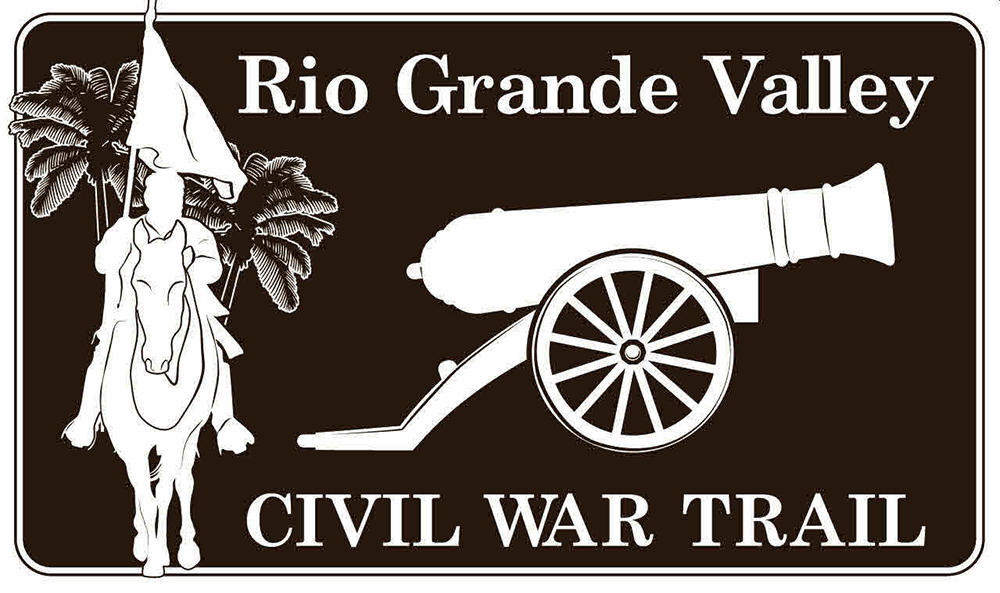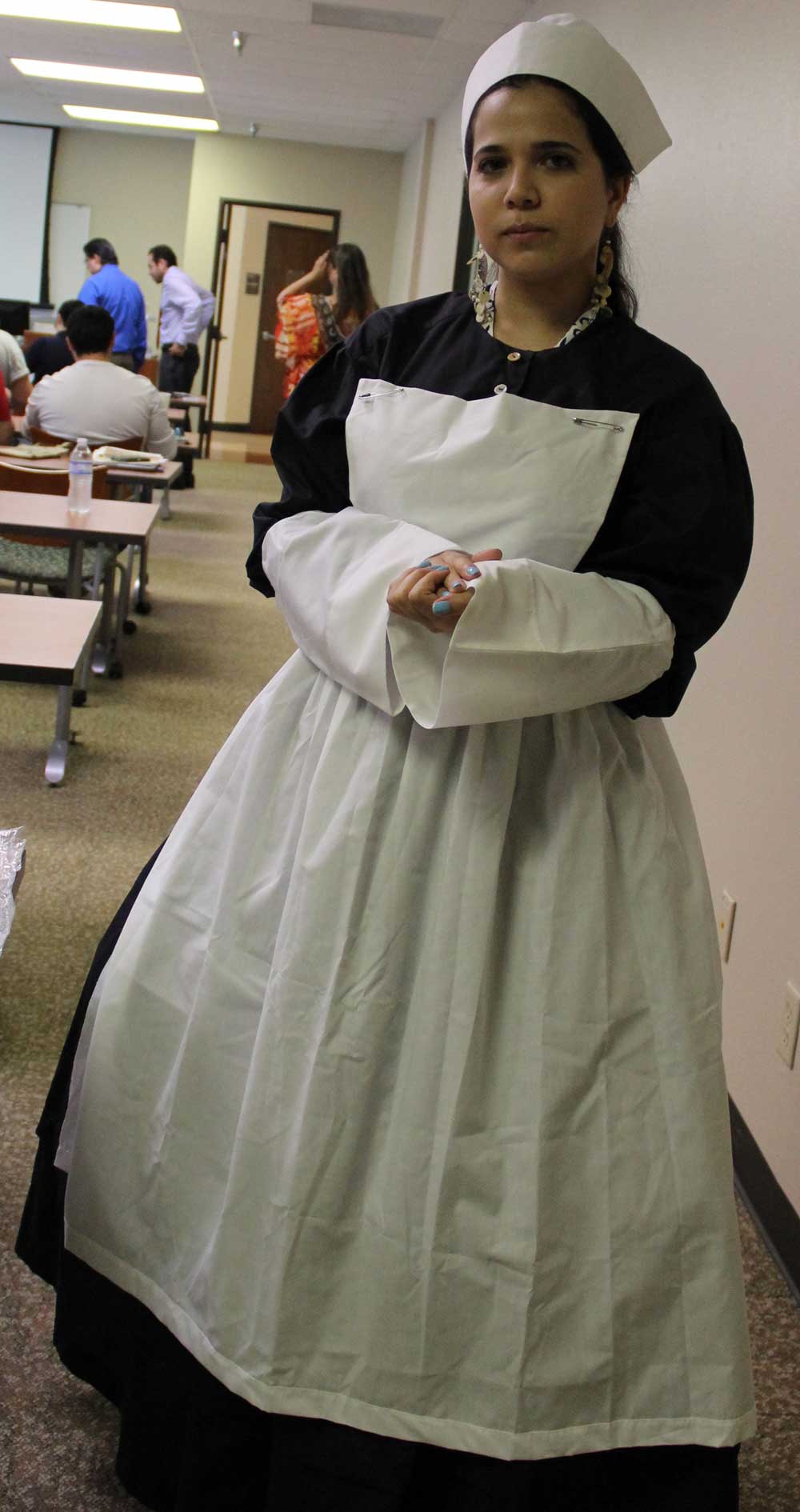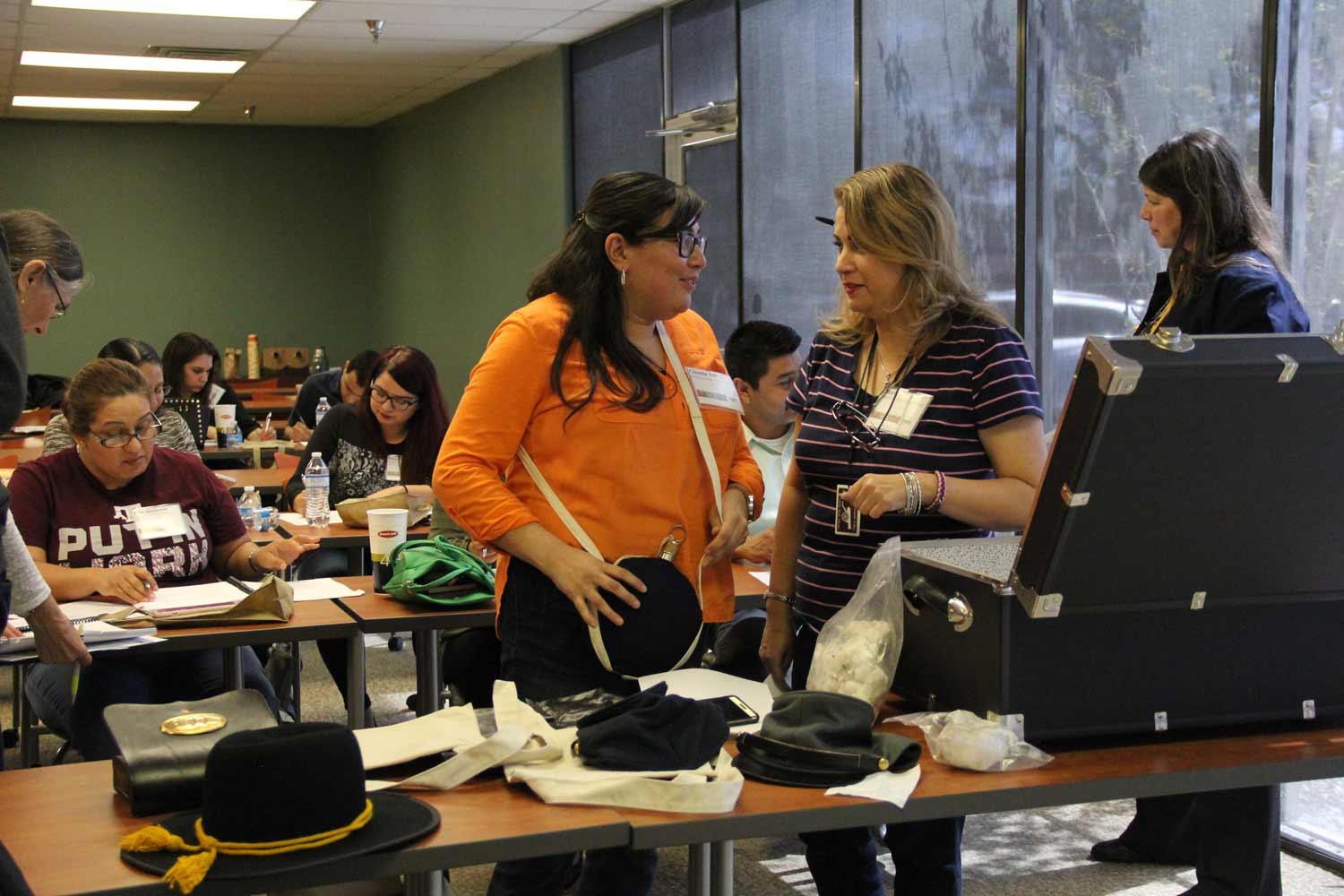The Rio Grande Valley Civil War Trail
by Christopher L. Miller
 Sometimes excavating American history involves more virtual digging than it does plying the soil with trowels. Sometimes it’s less about reassembling broken pottery than it is about reassembling broken information that’s buried just beneath the surface. It is this sort of excavating that has formed much of the mission for the Community Historical Archaeology Project with Schools (CHAPS) Program at the University of Texas Rio Grande Valley, as illustrated by one of its initiatives, the Rio Grande Valley Civil War Trail.
Sometimes excavating American history involves more virtual digging than it does plying the soil with trowels. Sometimes it’s less about reassembling broken pottery than it is about reassembling broken information that’s buried just beneath the surface. It is this sort of excavating that has formed much of the mission for the Community Historical Archaeology Project with Schools (CHAPS) Program at the University of Texas Rio Grande Valley, as illustrated by one of its initiatives, the Rio Grande Valley Civil War Trail.
Origins of the Project
Early in the spring of 2012, CHAPS co-directors Russell Skowronek and I were chatting about the promise of public history in the Rio Grande Valley in a darkened office on the campus of what was then the University of Texas−Pan American (UTPA). We recognized that we were just entering the second year of the sesquicentennial observations of the American Civil War. In most historical accounts of the Civil War and even general histories of Texas, there is little mention of the dramatic story of the many Civil War events that took place along the lower Rio Grande or the complex history of ethnic tension, international intrigue, and colorful characters that mark the Civil War era in this region. Oddly, Texas, which has capitalized on its Civil War heritage in so many ways, was one of the few participant states that did not have a trail devoted specifically to the American Civil War.
 With the aid of a graduate student and funding from the Summerlee Foundation of Dallas, we began to collect information about forts, battlefields, and historic structures from the Gulf of Mexico to Laredo. We planned to create a web-based “virtual” trail with a paper map/trail guide, audio podcasts, and educational traveling trunks containing replicas of items typical of Civil War life in this region, such as uniforms, camp gear, currency, and coins as well as a formal set of lesson plans geared to statewide curriculum guidelines. In late 2013, we met with the cities of Roma and Rio Grande City and the Brownsville Community Improvement Corporation and secured additional funding, which allowed us to proceed and bring together a group of community and professional supporters from across the region and country to discuss the feasibility and support for the creation of a Civil War trail.
With the aid of a graduate student and funding from the Summerlee Foundation of Dallas, we began to collect information about forts, battlefields, and historic structures from the Gulf of Mexico to Laredo. We planned to create a web-based “virtual” trail with a paper map/trail guide, audio podcasts, and educational traveling trunks containing replicas of items typical of Civil War life in this region, such as uniforms, camp gear, currency, and coins as well as a formal set of lesson plans geared to statewide curriculum guidelines. In late 2013, we met with the cities of Roma and Rio Grande City and the Brownsville Community Improvement Corporation and secured additional funding, which allowed us to proceed and bring together a group of community and professional supporters from across the region and country to discuss the feasibility and support for the creation of a Civil War trail.
Excavating the Rio Grande Valley Civil War Trail
The question now became how to actually dig up the stories of the people and places that would make up the trail. On May 22, 2014, less than one year before the sesquicentennial observations of the last battle of the American Civil War—at Palmito Ranch near Brownsville, Texas—the CHAPS team made its first effort at collecting those missing stories. Suspecting that there was a great deal of information retained in the living memory of community members, a meeting was convened at which nearly fifty individuals representing a broad swath of the community came together. We requested that they comb their individual neighborhoods to tap into the region’s lore.
With guidance from three “Project Scholars” in Civil War history (Dr. Jerry Thompson, Texas A&M International Regents Professor; Dr. W. Stephen McBride, Director of Archaeology, Camp Nelson Civil War Heritage Park, Kentucky; and Dr. James Leiker, Director, Kansas Studies Institute), the community broke into groups and selected members as lead advisors for each county. With this organization process established, each community member was charged with listening to his or her neighbors to identify Civil War–era sites and stories that would form the backbone for the overall project. By August more than fifty accounts of Civil War–era people, places, and events had been collected and compiled into 250-word narratives by the Rio Grande Valley community groups.
During the fall of 2014 the narratives were reworked as scripts for podcasts. These scripts and the narratives were translated into Spanish by Dr. José Dávila-Montes, professor of Spanish translation at the University of Texas−Brownsville. Once completed, the podcasts were recorded and these and the narratives were uploaded to the Rio Grande Valley Civil War Trail web page (www.utrgv.edu/civilwar-trail).
 By December the English portion of the Rio Grande Valley Civil War Trail web page went live. In February 2015, the Spanish narratives, English-language podcasts, and the bilingual map/brochure were complete. On February 27, 2015, a little more than nine months after the initial meeting, a workshop for teachers was held on the UTPA campus. More than fifty educators attended and shared their thoughts about how the trail might be integrated into their curricula, what sorts of items would be most effective in the traveling trunks—miniature portable museums containing items typical of Civil War life in this region—as well as the general topics they cover when discussing the Civil War in their classrooms. The next day the Rio Grande Valley Civil War Trail was officially launched with a ribbon cutting on the UTPA campus. More than 275 people attended a series of presentations and a Civil War living history camp. Among those in attendance were descendants of many of the key players in the stories we had collectively gathered.
By December the English portion of the Rio Grande Valley Civil War Trail web page went live. In February 2015, the Spanish narratives, English-language podcasts, and the bilingual map/brochure were complete. On February 27, 2015, a little more than nine months after the initial meeting, a workshop for teachers was held on the UTPA campus. More than fifty educators attended and shared their thoughts about how the trail might be integrated into their curricula, what sorts of items would be most effective in the traveling trunks—miniature portable museums containing items typical of Civil War life in this region—as well as the general topics they cover when discussing the Civil War in their classrooms. The next day the Rio Grande Valley Civil War Trail was officially launched with a ribbon cutting on the UTPA campus. More than 275 people attended a series of presentations and a Civil War living history camp. Among those in attendance were descendants of many of the key players in the stories we had collectively gathered.
Building on the Foundation
Since that ribbon cutting the Civil War Trail has continued growing. Drawing upon the historical materials that community members provided as well as original archival research by participating historical and archaeological professionals, two books are now completed and await publication by the Texas A & M University Press. Funding from the Summerfield G. Roberts Foundation of Dallas produced twenty-two of the traveling trunks for distribution to local school districts.
By listening to the community and excavating its historical memory, the Civil War Trail project has unearthed a number of understudied or entirely unstudied aspects of the war in the Rio Grande Valley of Texas. Four examples may serve as representative illustrations.
First, we learned about the complexity of the racial/ethnic composition of the region during that era. While the stereotype of this region is that it is bi-cultural (Anglo and Hispanic), during the middle decades of the nineteenth century demographics in this region were much more complex. The port of Matamoros at the mouth of the Rio Grande drew merchants, brokers, lawyers, naturalists, and a wide range of others from all around the world. Newspapers in that bustling port were published in English, Spanish, French, German, and other languages. In addition, because Mexico had banned slavery, the region became a refuge for African Americans fleeing the slave regime of the American South, escaping by just a ferry ride to freedom.
Second, we found out more about the motivations of South Texas residents for deciding which side to support in the war, or whether to participate at all. The issues of tariffs, regionally distinct economic systems, and especially slavery were not burning controversies in the Rio Grande Valley. However, many residents were sensitive to issues involving states’ rights as the result of multiple abortive revolutions against Mexican centralization during the early- to mid-nineteenth century. But even more important were the various political alliances that had emerged following the Mexican American War and disputed land claims throughout the region. Individuals such as Juan Nepomuceno Cortina sided largely with the Union because his political enemies, most particularly Santos Benavides, sided with the Confederacy. Such personal feuds and alliances were critical to the conduct of the war in the region.
Third, we learned about the enormous role that events in Mexico played in the Civil War in this region and internationally. In general histories of the Civil War the fact that Mexico was experiencing a civil war of its own during the same time period is at best treated as a trivial aside. We learned, however, from our community contacts that the wars in the US and Mexico were intimately interrelated for people in the Rio Grande Valley. Because the river had been designated as an international waterway, military authorities on either bank could not interfere with commerce on the river or with international shipping within eighteen miles of its mouth. As a result both rebel forces in Mexico and Texas used the river to ferry in arms, ammunition, medical supplies, and other war materiel and to export, for cash, millions of bales of cotton that had come by wagon from as far away as Arkansas. Not surprisingly, local families refer to this period as Los Algodones (the Cotton Times) and possess many stories about the role their ancestors played in this vibrant time. (For an introduction to this theme, see our short film Cotton Times available on YouTube at https://www.youtube.com/watch?v=GXF_K9O4oDA or on our website.)
 Fourth, we learned about the role played by African American troops during and after the war. On May 22, 1863, the US Army issued General Order 143 allowing formerly enslaved African Americans to enlist in the military. In response, the 25th Corps of the US Colored Troops (USCT) was created in Virginia and, by the war’s end, was composed of almost 180,000 men, between ten and fifteen percent of the entire Union force. Contingents of these troops participated in the 1863 Union invasion of the Rio Grande Valley and remained in the region throughout the balance of the war. They took part in the last land battle of the war—the Battle of Palmito Ranch—in 1865 and then composed the majority of the army of occupation in the region. Writing home to Kentucky from an outpost on the Rio Grande, a former slave, Sergeant Major Thomas Boswell, remarked: “If our regiment stays here any length of time we will all speak Spanish, as we are learning very fast.” Many of them did learn Spanish, married local women, and stayed in the region, adding to its heritage and diversity.
Fourth, we learned about the role played by African American troops during and after the war. On May 22, 1863, the US Army issued General Order 143 allowing formerly enslaved African Americans to enlist in the military. In response, the 25th Corps of the US Colored Troops (USCT) was created in Virginia and, by the war’s end, was composed of almost 180,000 men, between ten and fifteen percent of the entire Union force. Contingents of these troops participated in the 1863 Union invasion of the Rio Grande Valley and remained in the region throughout the balance of the war. They took part in the last land battle of the war—the Battle of Palmito Ranch—in 1865 and then composed the majority of the army of occupation in the region. Writing home to Kentucky from an outpost on the Rio Grande, a former slave, Sergeant Major Thomas Boswell, remarked: “If our regiment stays here any length of time we will all speak Spanish, as we are learning very fast.” Many of them did learn Spanish, married local women, and stayed in the region, adding to its heritage and diversity.
Continuing Excavation
It has now been five years since the idea of a Rio Grande Valley Civil War Trail was first conceived, but much remains to be dug up and interpreted. The CHAPS team continues to work with the local communities along the Rio Grande to tease out still more evidence of the region’s role in this monumental struggle over the nation’s destiny. It is our hope that this excavation will continue until every buried shard has been unearthed and shared broadly with our community and the world.
Christopher L. Miller is Professor of History and Co-director of the Community Historical Archaeology Project with Schools at the University of Texas Rio Grande Valley. He is the author of Prophetic Worlds: Indians and Whites on the Columbia Plateau, co-author of Making America: A History of the United States, co-editor with Tamer Balcı of The Gülen Hizmet Movement: Circumspect Activism in Faith-Based Reform (2012), and co-editor with Russell K. Skowronek and Roseann Bacha-Garza of War and Peace on the Rio Grande, 1846–1876.









































































